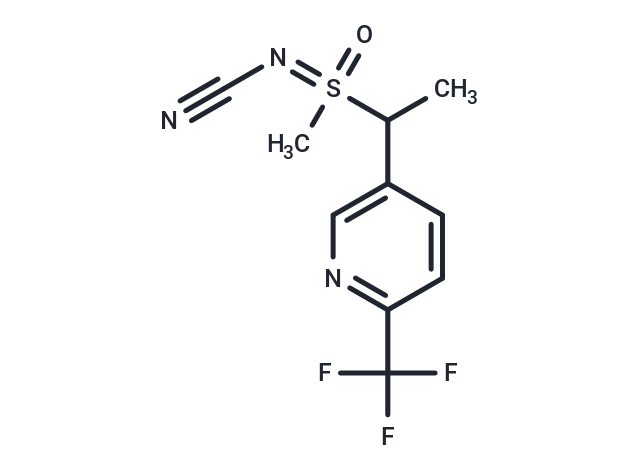Shopping Cart
- Remove All
 Your shopping cart is currently empty
Your shopping cart is currently empty

Sulfoxaflor (GF 2032) is an agonist of nAChR1 and nAChR2 subtypes and a systemic insecticide that acts on the insect central nervous system. Sulfoxaflor was found to have some effects on peripheral blood lymphocytes and is used to control sap-feeding insects such as brown planthopper, whitefly, peach aphid, and cotton aphid.

| Pack Size | Price | Availability | Quantity |
|---|---|---|---|
| 1 mg | 107 € | In Stock | |
| 5 mg | 305 € | In Stock | |
| 10 mg | 455 € | In Stock | |
| 25 mg | 729 € | In Stock | |
| 50 mg | 997 € | In Stock | |
| 100 mg | 1.320 € | In Stock |
| Description | Sulfoxaflor (GF 2032) is an agonist of nAChR1 and nAChR2 subtypes and a systemic insecticide that acts on the insect central nervous system. Sulfoxaflor was found to have some effects on peripheral blood lymphocytes and is used to control sap-feeding insects such as brown planthopper, whitefly, peach aphid, and cotton aphid. |
| In vitro | METHODS: Blood lymphocytes were treated with Sulfoxaflor (GF 2032) (10 µg/mL, 20 µg/mL, 40 µg/mL), and single cell gel electrophoresis (comet electrophoresis), cytokinesis block micronucleus assay (MN assay), flow cytometry, and catalase (CAT) enzyme activity measurement were used to determine genotoxicity, apoptotic effects, and oxidative damage potential, respectively. RESULTS CPBI values and the number of viable cells decreased; the number of late apoptotic and necrotic cells, micronucleus frequency, and comet assay parameters (GDI and DCP) increased; an increase in CAT enzyme levels was observed at 10 and 20 µg/mL concentrations, and CAT enzyme activity was inhibited at 40 µg/mL. [3] |
| In vivo | METHODS: Sulfoxaflor (GF 2032) (25, 100, and 500 mg/kg, gavage, 4 weeks) was administered to rats and the relative testicular mass, testosterone, FSH, LH, MDA, and GPx levels, sperm motility, sperm morphology, sperm DNA damage, and histopathological changes in the testis, epididymis, and seminal vesicle were examined. RESULTS Sulfoxaflor exposure resulted in an increase in FSH, LH, MDA, and GPx levels in sperm, as well as the percentage of dead and abnormal sperm and DNA damage in rat sperm. [2] |
| Alias | XDE 208, GF 2372, GF 2032 |
| Molecular Weight | 277.27 |
| Formula | C10H10F3N3OS |
| Cas No. | 946578-00-3 |
| Smiles | C(S(=NC#N)(C)=O)(C)C=1C=CC(C(F)(F)F)=NC1 |
| Relative Density. | 1.31g/cm3 |
| Storage | Powder: -20°C for 3 years | In solvent: -80°C for 1 year | Shipping with blue ice. | |||||||||||||||||||||||||||||||||||
| Solubility Information | DMSO: 55 mg/mL (198.36 mM), Sonication is recommended. | |||||||||||||||||||||||||||||||||||
Solution Preparation Table | ||||||||||||||||||||||||||||||||||||
DMSO
| ||||||||||||||||||||||||||||||||||||

Copyright © 2015-2025 TargetMol Chemicals Inc. All Rights Reserved.